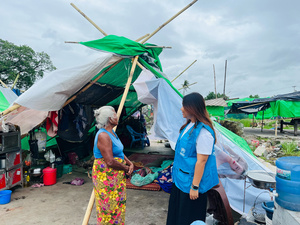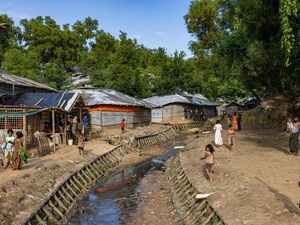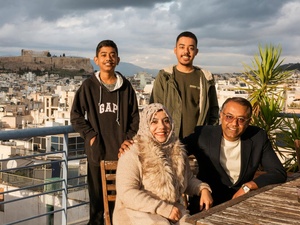Rebuilding from the ashes in Cox's Bazar
Rebuilding from the ashes in Cox's Bazar

Nossima Fatima and her daughter resting in their shelter in Cox's Bazar, Bangladesh.
“I woke up to a fire, scared, clueless and in shock. I didn’t know what to do until volunteers came in to help me.”
Nossima Fatima, a 30-year-old Rohingya mother of three living in a refugee camp in Cox’s Bazar, Bangladesh, was saved by three refugee volunteers trained to contain fires, after a fire broke out in her shelter in October. It took them less than 15 minutes to extinguish the flames using fire extinguishers, sand and water. But by then, the damage was done.
“I lost everything. Curtains, clothes, pots. Everything,” laments Nossima. She is thankful that her children were not home when it happened. “There was fire everywhere, on the roof, out the window, you could see it from far away which is why my children came running to find me when they saw the smoke.”
Fires can spread quickly in the camps due to overcrowding and poor infrastructure. Last year UNHCR, the UN Refugee Agency, together with Bangladeshi authorities, IOM and other aid agencies, helped thousands of families rebuild their lives following fires.
“My children remember the incident and sometimes fear to sleep in here.”
Nossima still remembers the screams and cries of her son and daughters as they saw their home burn down. In the first hours after the fire, she was inconsolable, the little they had managed to carry with them when they fled from Myanmar burnt to ashes. The only thing they managed to save were their identification documents, their lifelines to access services and food in the refugee camp.
While the foundations were salvageable, the roof had to be completely replaced. A new tarpaulin was installed, and the walls were repaired. Despite the restoration, black spots on the supporting beams still haunt the family, who share nightmares about the day of the fire.
“My children remember the incident and sometimes fear to sleep in here,” says Nossima. Moving is not an option in the overcrowded camps in Cox’s Bazar.
The reconstruction of shelter and distribution of essentials such as blankets, cooking utensils and lamps are made possible by generous government and private sector donors, including the Big Heart Foundation, whose timely contributions were critical to assist the affected population in 2021.
Hundreds of refugee volunteers are continuously trained across the camps to prevent and respond to fires. Their work is crucial to stop fires as their reaction time is shorter and they can quickly and effectively reach the affected families.
In 2021, UNHCR also introduced fire response vehicles to prevent future tragedies. A fire in one of the camps on 18 January 2022 was rapidly contained using one of these vehicles, limiting the damage to 27 shelters and preventing fatalities. Destroyed shelters are rebuilt with support from humanitarian agencies, and fire breaks are introduced to reduce the risk of spread, whenever space allows.
The impact of the fires has also had huge effects on refugee’s mental health. While most shelters have been restored or replaced, mental health workers in the camps still have much work to do. For many like Nossima, there is still a long way to recovery from the trauma of the fire, having already suffered a great loss when they were forced to flee Myanmar.








